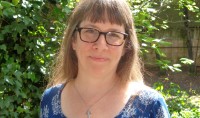In Woolf's footsteps

In the spring, the poet Geoffrey Chaucer famously wrote, humans long to travel. Once the flowers bloom and the birds take up their song again—and, we might add, once we have shucked off our heavy coats and put away the snow shovel—“than longen folk to goon on pilgrimages.”
During spring break I made a pilgrimage. With my husband and my daughter, I traced the path novelist Virginia Woolf took through Italy in 1908, when she was still Virginia Stephen. I followed in her footsteps as best I could, searching for the sights she described in her diary, standing before works of art she analyzed and puzzled over.
Read our latest issue or browse back issues.
It is almost the definition of pilgrimage that we follow in the footsteps of others. The Via Dolorosa in Jerusalem, the route to Santiago de Compostela in Spain—these paths have been traveled by countless pilgrims, been prayed over and wept over. When we step onto those pilgrimage roads we join all those who have traveled them. We join our prayers to their prayers and, in a very real sense, we join our lives to theirs.
Pilgrims have long sought not only religious inspiration but artistic inspiration through pilgrimage. In her memoir Just Kids, the great rock ’n’ roll poet Patti Smith describes walking through New York City as a young aspiring artist, following Frank O’Hara’s footsteps up Second Avenue and following the spirit of Dylan Thomas through the doors of the Chelsea Hotel. Seventeenth-century haiku master Matsuo Bashō walked thousands of kilometers in the footsteps of the artists he admired. When he came across a tree described by ancient poets, or found a stone where a poet had once stopped to rest, or saw the moon rise above a mountain he had seen described in a poem, he would feel the presence of the poets he loved, recall their poems and experience the generativity of the Japanese landscape, just as his ancient mentors had. Bashō’s own poetry flowed from these encounters.
My pilgrimage was also layered with the presence of someone who had gone before me: Virginia Woolf, who traveled to Italy as a young writer to think amid Italian art and Italian landscapes about the kind of beauty she hoped to create in her novels. I wanted to see that young writer more clearly and to understand how her engagement with religious art shaped her own artistic achievement.
The artist with whom Woolf thinks most often is Perugino, the Umbrian painter and teacher of Raphael. In his frescoes and paintings, figures of rounded, harmonious beauty stand in carefully arranged groups. Often they are looking off into the distance as if listening to music that only they can hear. Woolf experienced Perugino’s frescoes as “infinitely silent” and intensely beautiful, with all the beauty held and sealed in the human figures.
When she wrote about her encounters with Perugino’s art in her journal, she tried to analyze the difference between the beauty he expressed in his frescoes and the beauty she was after in her writing. She wrote of her desire to achieve beauty and symmetry, but beauty made of “infinite discords,” “shivering fragments”—the beauty of the complex, fragmented ways that human beings experience the world.
I imagine this young, unknown Englishwoman wandering through Italian churches and galleries, studying the work of artists from hundreds of years ago, paying attention to what moved her, wondering how to achieve something similar in words, measuring how far her artistic goals were from theirs. She was doing momentous but hidden work, articulating to herself the artistic convictions that would eventually give rise to her masterpieces.
What was I looking for as I followed her from town to town and stood in front of the works of art she had stood before a century earlier? Why did it feel like a pilgrimage?
I wanted to experience as closely as I could those moments when the shape of her vocation came into view. Woolf was a genius; I am not. But when I tried to see through her eyes with the same quality of attention she brought to her pilgrimage, I felt my vision refreshed and my devotion to my work renewed.
In her journal Woolf poked fun at English tourists—including herself—for believing that their analysis had an effect on the art they went to Italy to see. The art remains the same, she concluded; we, standing before it, are what changes. We may think that we unveil the art, but it is the art that “bids us reveal ourselves.”
Every pilgrimage bids us to reveal ourselves. What pilgrims do for each other on the road is to help this process along: to ask each other questions, to listen, to share what is most deeply at stake for us in the journey. On your own pilgrimages this summer, be sure to leave something for another to find and think with: a prayer, a question, a long conversation. We need one another, the living and the dead, to glimpse who we are and who we might become.






